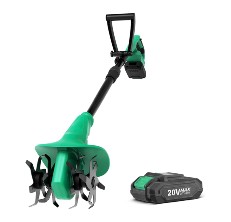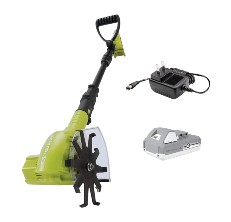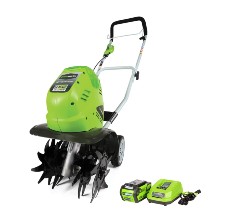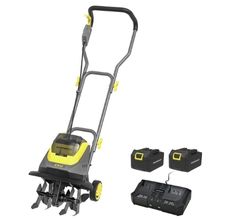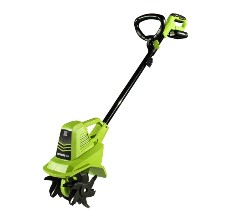- Flowers & PlantsVegetablesOur content is meticulously curated through independent research, testing, reviews, and AI-driven recommendations, all designed to present you with the finest product choices. When you make a purchase through our links, it could result in us earning a commission.
Best Cordless Cultivators to Prepare the Perfect Seedbed
 Last updated: Mar 12, 2024
Last updated: Mar 12, 2024A garden can only grow plants with good soil. Good soil involves aerated earth, tilling, and the removal of weeds. This can take days, if not weeks, for someone to do alone, especially if done only with a spade and a ton of sweat. However, modern technology has come with plenty of conveniences, and even farming and gardening have seen a positive impact thanks to these advances. As such, even the process of tilling has become an easy task for even the most novice of gardeners with the best cordless cultivators.
One drawback of using electronically powered tools is the need for a cord. For example, you could only vacuum with a vacuum cleaner as far as the cord would let you. Well, that’s not the case anymore with electric tillers – these devices now run on batteries to save you the effort of bringing in tons of extension cords. We’re showcasing some of the best cultivators that will make tilling, weeding, and everything else a breeze.
Show contentsWhat Is the Leading Cordless Cultivator of 2024?- K I M O. Cordless Tiller Cultivator - Best Overall
- Sun Joe Telescoping Power Weeder_Cultivator - Runner Up
- Greenworks 40V 10 inch Cordless Cultivator - Honorable Mention
- PowerSmart Cordless Cultivator - Contender
- Earthwise TC70020 Electric Tiller Cultivator - Most Durable
A Complete Buying Guide to Cordless CultivatorsA Complete Buying Guide to Cordless Cultivators
When tilling the soil, you’ll find that cordless cultivators make the whole process much, much easier. But what type of electric tiller should you get? Is there an ideal tiller cultivator for every garden? Read on to learn more about these handy tools.
What Is a Cordless Cultivator?
A cordless cultivator, also known as an electric tiller, is an electric tool that tills the garden beds or seedbeds. The tool uses a battery to run, and as such does not require any plugging into a wall socket. Electric tillers can run for up to an hour or so before needing a recharge, depending on the model and its battery life.
Why Is It Important To Have an Electric Tiller?
They save you time and effort
Have you ever tried tilling the soil by hand with a spade? Or have you attempted to remove weeds from an entire garden patch one by one? If so, then you know how tiring using hand tools can be. If you don’t have the time to do so, it can be very problematic, and even if you do find time, it’ll often take the better part of the day to finish and really do it properly. If you’d rather not waste time and effort doing something that’s so labor-intensive, then you may want to invest in an electric tiller.
To see just how beneficial they can be and for additional information, check out this video from Paloma Farm and Landscape:
They’re easy to use
One of the biggest advantages of cordless cultivators is their ease of use. Many devices often just have a button or two. All you have to do is place the tiller cultivator in the soil, activate it, and move it along your yard or home garden. This is much, much easier than using a spade and doing everything by hand. You’ll also have less room for error, as you can easily go back and cover untilled ground that you may have missed.
They’re great for people with back pain
Okay, let’s say that you’ve tilled your soil before by hand and you don’t mind doing it again. The question now is – can you do it without hurting yourself? Many gardeners often experience back pain due to being hunched over with their hand tools for long periods of time. This can be easy to deal with at first, but if you’re going to be tilling for a while, it can even cause long-term issues. If you value your back (which you probably should), you’ll want to use an electric tiller to allow you to stand upright with your back in a rested position. In this case, buying a tiller cultivator for the sake of your physical health is well worth the cost. Electric tillers provide an easy way to cultivate the soil for people who experience back pain.
They’re better for you and the environment
Traditional cultivators that run on gasoline are not great for you or the environment. Using a gas-powered tiller cultivator in a covered greenhouse is especially harmful to your health due to the inability of the gas fumes to escape. Electric tillers don’t produce any fumes, so they are better for you and the earth. By using a battery-powered tiller, you can stay healthier and reduce your carbon footprint.
Tips When Using an Electric Tiller
Take your time while tilling
Although electric tillers do most of the work for you, you don’t want to rush things and just run your tiller cultivator through the soil like a madman. This can result in haphazardly tilled garden beds, and in the worst of cases, you could even damage your electric tiller. This is the last thing you’d want to happen, especially if you had spent hundreds of dollars on a single tool.
When using an electric tiller, take your time as you move across the soil. Wait for the tiller cultivator to do its work, and once the soil directly in front of you has been tilled sufficiently, you can move on to the next patch. Just because cultivators make the process faster doesn’t mean you should try to rush things, especially when it comes to gardening.
Charge before using
This may be a no-brainer for a lot of gardeners, but you’d be surprised by the number of people who would use their electric tillers without actually charging them properly. Just because they’re battery-powered doesn’t mean they’ll always have juice. If you leave the cultivator unused for long enough, the power of the lithium ion battery will naturally dissipate, and you’ll need to charge it again before it becomes usable.
To save yourself some time, it’s a good idea to charge the lithium ion battery of the tiller cultivator the night before you till the flower beds, or at the very least an hour or so in advance so that you get optimal run time. Be sure to keep the battery in sight at all times while you’re charging to ensure that no accidents happen. Things like house fires can start all because of a spark, so be sure you don’t take any chances.
Finally, if you have a model with a fast charger and battery, you can decide to ignore this tip and simply charge right before you use it. Of course, there will be some downtime while you wait for the electric tiller to charge, but you can always do something else in the meantime, such as preparing your seeds and whatnot. Just be sure to check on your lithium ion battery every now and then, and you should be good.
Keep a spare battery available
Even if you fully charge your battery, there’s only so much juice a battery can hold – no battery has an infinite run time. Eventually, you will need to recharge the battery, which can be a problem if you’re not done tilling the land. You’d be wasting time waiting for the battery to recharge, and even if it was fast-charging, you’d still be burning daylight. That’s why keeping a spare battery that is fully charged available is great for extended tilling sessions. And even though making sure the battery is charged can be inconvenient, it sure beats having to pay for gas or lugging around an extension cord for a plug-in tiller.
Electric Tiller Price Range
Cordless cultivators vary greatly in price depending on their specs and features. The cheapest electric tillers will cost you no more than $100, though they are often not very heavy-duty and are best used for a small home garden. More large-scale electric tillers will cost you upwards of $200 or more depending on the brand.
What Is the Leading Cordless Cultivator of 2024?
1K I M O. Cordless Tiller Cultivator
– Best OverallCordless cultivators can be handy to use, and some may even be fine with waiting for the battery to charge. But what if you could replace the dead battery with a new one and immediately go back to work while the other one recharges? This tool gives you that special privilege with its unique detachable battery design. The battery can be removed and replaced on a whim, so if you’ve still got unfinished business, you can immediately get back to work.
Pros- Replaceable battery
- Auxiliary handle
Cons- Only one battery is available on its own
2Sun Joe Telescoping Power Weeder_Cultivator
– Runner UpSo, we’ve showcased a cordless cultivator that deals with its one major flaw – battery life. But there’s still one big reason as to why many people don’t get cordless cultivators – the price. At the end of the day, cordless cultivators are more of a luxury than a necessity, as anybody with enough elbow grease can till their own yard manually. But what if the barrier to entry wasn’t so high, and you could get a cultivator for less than $100?
Pros- Affordable
- Up to 60 minutes of runtime
Cons- Only one tilling wheel
3Greenworks 40V 10 inch Cordless Cultivator
– Honorable MentionEven with the power of technology, some soil is just too tough for conventional cordless cultivators to till. There’s a limit to how much power can be outputted through batteries, after all – or is there? Introducing the Greenworks Cordless Cultivator. You’ll immediately notice that it’s different from other cultivators we’ve showcased because it features more tilling wheels as well as rubber wheels to move the tool more efficiently.
Pros- Heavy-duty cultivator
- Powerful battery and motor
Cons- A bit too large for some gardeners
4PowerSmart Cordless Cultivator
– ContenderThe PowerSmart Cordless Cultivator is a great tool for those looking to prepare their garden for the growing season. This powerful tiller packs a punch with its brushless motor and allows for up to 40 minutes of runtime. With a 4-position wheel adjustment and a max tilling depth of 7.8 inches, and tilling width of 11.8 inches, you can easily tackle any size garden with ease.
Safety is also important when it comes to garden tools, and this cultivator has double safety protection with a Safety Button and Overload Protection to keep you safe in the garden. Storage is also made easy with a handle that folds for convenient storage and easy transport. And lastly, you don’t need to worry about running out of power as two 20V 4.0Ah batteries and a charger are included, along with an LED power display.
Pros- Easy to use
- Has a user-friendly design
- Stylish and modern look
Cons- Doesn’t work well on hard soil
5Earthwise TC70020 Electric Tiller Cultivator
– Most DurableWe’re starting off this list with a great cultivator that’s perfect for those who want to get back on the action immediately. Cordless cultivators are great, but their biggest disadvantage is that they will eventually run out of power. This will require you to recharge the cultivator, which will end up with you burning daylight and wasting precious time. If you want to minimize downtime while you work, you’ll need a fast-charging cultivator, and this device is just that.
Pros- Fast-charging
- Durable build
Cons- Neon color may not appeal to some
People Also Asked
Q: Are cordless cultivators reliable?A: Cordless cultivators can reliably till the ground beneath them through the use of motors and batteries.
Q: Are cordless cultivators safe?A: While you won’t have to worry about tripping on any cords while using them, cordless cultivators still use electrically powered blades and wheels, and you should be careful not to put your feet or anything other than soil too close to them.
Q: Are cordless cultivators good for weeding?A: Cordless cultivators are great for tilling the ground, and by extension, they’re also great for removing weeds at their roots by unearthing them from the soil.
The Garden Gate Review Team’s product reviews and in-depth guides are here to help you choose the best products for a beautiful and bountiful garden and backyard. The content is created by The Garden Gate Review Team. Garden Gate’s editorial staff is not involved. Garden Gate is reader-supported: When you buy through links on our site, we may earn an affiliate commission. The Garden Gate Review Team is composed of authors, editors, and gardeners. Artificial Intelligence (large language models) may have been used in the research and creation of the content. Please reach out to aimperiapt@gmail.com with any questions regarding product testing or specific articles.
